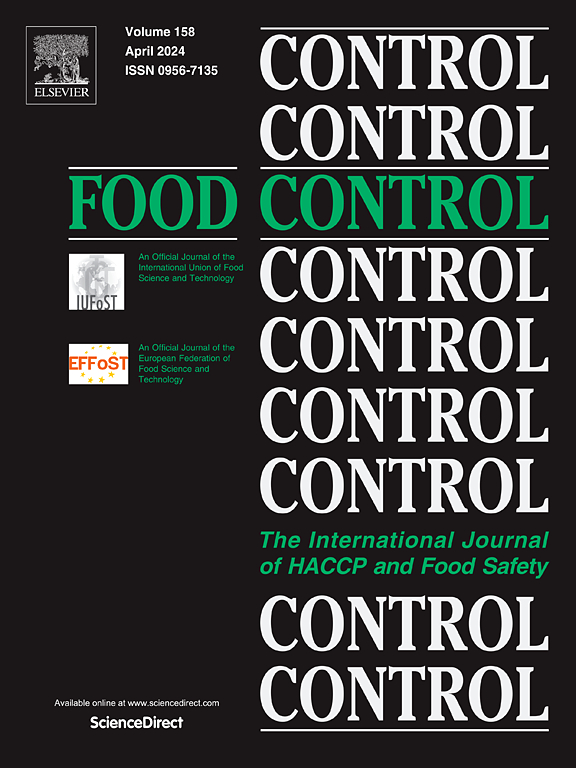Quantitative and qualitative analysis of buffalo milk adulteration using Raman spectroscopy and chemometric–deep learning models
IF 6.3
1区 农林科学
Q1 FOOD SCIENCE & TECHNOLOGY
引用次数: 0
Abstract
Buffalo milk is nutritionally rich but vulnerable to adulteration, posing challenges to food safety. This study analyzes buffalo milk, soybean milk, Holstein milk, and five common additives—ammonium chloride, urea, sodium bicarbonate, sodium citrate, and sucrose—using Raman spectroscopy. Six spectral preprocessing methods were systematically evaluated to enhance model performance. For qualitative detection, PLS-DA models combined with Multiplicative Scatter Correction (MSC) preprocessing achieved excellent classification accuracy (up to 100 %) for pure buffalo milk, water, and soybean milk adulteration.
For quantitative analysis, both PLS and MSC-CNN regression models were developed. The MSC-CNN model achieved high predictive performance for sodium bicarbonate (R2 = 0.97) and sodium citrate (R2 = 0.93), with RMSEP <5 % of full scale. Detection limits were as low as 17.4 mg/kg for sodium bicarbonate and 20.9 mg/kg for sodium citrate, meeting practical sensitivity requirements. Compared with existing PLS-based methods, our approach improved predictive accuracy and expanded low-concentration detection. The proposed Raman–deep learning strategy offers a rapid, accurate, and non-destructive solution for milk adulteration monitoring and quality control.
利用拉曼光谱和化学计量学深度学习模型对水牛奶掺假进行定量和定性分析
水牛奶营养丰富,但容易掺假,对食品安全构成挑战。本研究使用拉曼光谱分析了水牛奶、豆浆、荷斯坦牛奶以及五种常见的添加剂——氯化铵、尿素、碳酸氢钠、柠檬酸钠和蔗糖。系统评价了六种光谱预处理方法以提高模型性能。在定性检测方面,PLS-DA模型结合乘法散射校正(MSC)预处理对纯水牛奶、水和豆浆掺假的分类精度达到100%。为了进行定量分析,我们建立了PLS和MSC-CNN回归模型。MSC-CNN模型对碳酸氢钠(R2 = 0.97)和柠檬酸钠(R2 = 0.93)具有较高的预测性能,RMSEP为满量程的5%。检测限低至17.4 mg/kg的碳酸氢钠和20.9 mg/kg的柠檬酸钠,满足实际灵敏度要求。与现有的基于pls的方法相比,我们的方法提高了预测精度,扩展了低浓度检测。提出的拉曼深度学习策略为牛奶掺假监测和质量控制提供了快速、准确和非破坏性的解决方案。
本文章由计算机程序翻译,如有差异,请以英文原文为准。
求助全文
约1分钟内获得全文
求助全文
来源期刊

Food Control
工程技术-食品科技
CiteScore
12.20
自引率
6.70%
发文量
758
审稿时长
33 days
期刊介绍:
Food Control is an international journal that provides essential information for those involved in food safety and process control.
Food Control covers the below areas that relate to food process control or to food safety of human foods:
• Microbial food safety and antimicrobial systems
• Mycotoxins
• Hazard analysis, HACCP and food safety objectives
• Risk assessment, including microbial and chemical hazards
• Quality assurance
• Good manufacturing practices
• Food process systems design and control
• Food Packaging technology and materials in contact with foods
• Rapid methods of analysis and detection, including sensor technology
• Codes of practice, legislation and international harmonization
• Consumer issues
• Education, training and research needs.
The scope of Food Control is comprehensive and includes original research papers, authoritative reviews, short communications, comment articles that report on new developments in food control, and position papers.
 求助内容:
求助内容: 应助结果提醒方式:
应助结果提醒方式:


